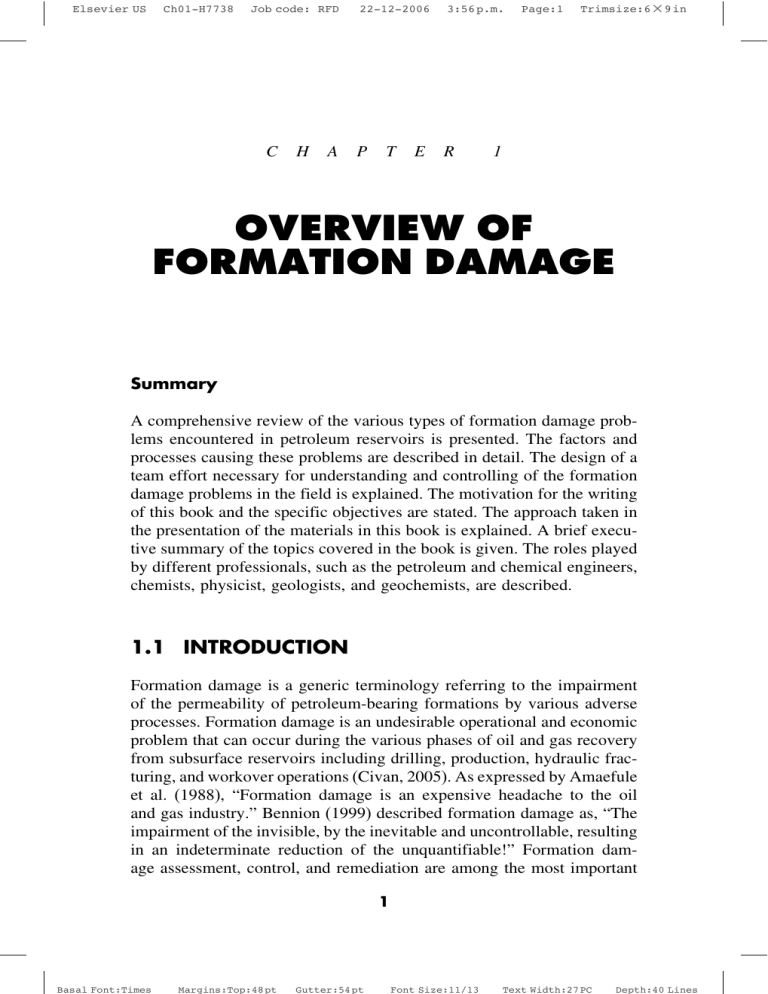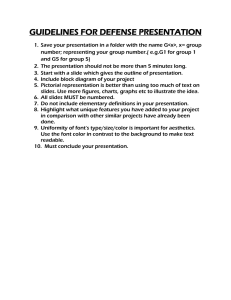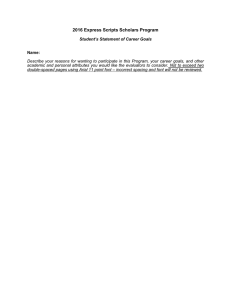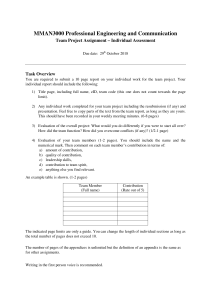
Elsevier US Ch01-H7738 Job code: RFD C H A 22-12-2006 3:56 p.m. P R T E Page:1 Trimsize:6×9 in 1 OVERVIEW OF FORMATION DAMAGE Summary A comprehensive review of the various types of formation damage problems encountered in petroleum reservoirs is presented. The factors and processes causing these problems are described in detail. The design of a team effort necessary for understanding and controlling of the formation damage problems in the field is explained. The motivation for the writing of this book and the specific objectives are stated. The approach taken in the presentation of the materials in this book is explained. A brief executive summary of the topics covered in the book is given. The roles played by different professionals, such as the petroleum and chemical engineers, chemists, physicist, geologists, and geochemists, are described. 1.1 INTRODUCTION Formation damage is a generic terminology referring to the impairment of the permeability of petroleum-bearing formations by various adverse processes. Formation damage is an undesirable operational and economic problem that can occur during the various phases of oil and gas recovery from subsurface reservoirs including drilling, production, hydraulic fracturing, and workover operations (Civan, 2005). As expressed by Amaefule et al. (1988), “Formation damage is an expensive headache to the oil and gas industry.” Bennion (1999) described formation damage as, “The impairment of the invisible, by the inevitable and uncontrollable, resulting in an indeterminate reduction of the unquantifiable!” Formation damage assessment, control, and remediation are among the most important 1 Basal Font:Times Margins:Top:48 pt Gutter:54 pt Font Size:11/13 Text Width:27 PC Depth:40 Lines Elsevier US Ch01-H7738 Job code: RFD 2 22-12-2006 3:56 p.m. Page:2 Trimsize:6×9 in Overview of Formation Damage issues to be resolved for efficient exploitation of hydrocarbon reservoirs (Energy Highlights, 1990). Formation damage may be caused by many factors, including physico-chemical, chemical, biological, hydrodynamic, and thermal interactions of porous formation, particles, and fluids, and the mechanical deformation of formation under stress and fluid shear. These processes are triggered during the drilling, production, workover, and hydraulic fracturing operations. Ordinarily, the mineral matter and fine particles loosely attached to the pore surface are at equilibrium with the pore fluids. However, variations in chemical, thermodynamic, and stress states may create nonequilibrium conditions and induce the salinity, velocity, and thermal shock phenomena and particle detachment and precipitate formation. When the equilibrium condition existing between the pore surface and the fluids is disturbed during reservoir production by primary and enhanced recovery processes, the mineral matter may dissolve and generate many different ions in the aqueous phase and the fine particles are unleashed from the pore surface into the fluid phases. Once these ions and particles are introduced into the fluid phases, they become mobile. Thus, a condition is created, like a bowl of soup of the mobile ions and fine particles in the pore space, which may interact freely with each other in many intricate ways to create severe reservoir formation damage problems. Formation damage indicators include permeability impairment, skin damage, and decrease of well performance. As stated by Porter (1989), “Formation damage is not necessarily reversible” and “What gets into porous media does not necessarily come out.” Porter (1989) called this phenomenon “the reverse funnel effect.” Therefore, it is better to avoid formation damage than to try to restore it. A verified formation damage model and carefully planned laboratory and field tests can provide scientific guidance and help develop strategies to avoid or minimize formation damage. Properly designed experimental and analytical techniques, and the modeling and simulation approaches can help understanding diagnosis, evaluation, prevention, remediation, and controlling of formation damage in oil and gas reservoirs. The consequences of formation damage are the reduction of the oil and gas productivity of reservoirs and noneconomic operation. Therefore, it is essential to develop experimental and analytical methods for understanding and preventing and/or controlling formation damage in oiland gas-bearing formations (Energy Highlights, 1990). The laboratory experiments are important steps in reaching an understanding of the physical mechanisms of formation damage phenomena. “From this Basal Font:Times Margins:Top:48 pt Gutter:54 pt Font Size:11/13 Text Width:27 PC Depth:40 Lines Elsevier US Ch01-H7738 Job code: RFD 22-12-2006 3:56 p.m. Page:3 Trimsize:6×9 in 3 Overview of Formation Damage experimental basis, realistic models which allow extrapolation outside the scaleable range may be constructed” (Energy Highlights, 1990). These efforts are necessary to develop and verify accurate mathematical models and computer simulators that can be used for predicting and determining strategies to avoid and/or mitigate formation damage in petroleum reservoirs (Civan, 1994). Confidence in formation damage prediction using phenomenological models cannot be gained without field testing. Planning and designing field test procedures for verification of the mathematical models are important. Once a model has been validated, it can be used for accurate simulation of the reservoir formation damage and designing effective measures for formation damage mitigation. Current techniques for reservoir characterization by history matching do not consider the alteration of the characteristics of reservoir formation during petroleum production. In reality, formation characteristics vary (Civan, 2001, 2002a,b,e) and a formation damage model can help to incorporate this variation into the history matching process for accurate characterization of reservoir systems and, hence, an accurate prediction of future performance. Formation damage is an exciting, challenging, and evolving field of research. Eventually, the research efforts will lead to a better understanding and simulation tools that can be used for model-assisted analysis of rock, fluid, and particle interactions and the processes caused by rock deformation and scientific guidance for development of production strategies for formation damage control in petroleum reservoirs. In the past, numerous experimental and theoretical studies have been carried out for the purpose of understanding the factors and mechanisms that govern the phenomena involving formation damage. Although various results were obtained from these studies, a unified theory and approach still does not exist. In spite of extensive research efforts, development of technologies and optimal strategies for cost-effective mitigation of formation damage is still as much art as science. Civan (1996) explains A formation damage model is a dynamic relationship expressing the fluid transport capability of porous medium undergoing various alteration processes. Modeling formation damage in petroleum reservoirs has been of continuing interest. Although many models have been proposed, these models do not have the general applicability. However, an examination of the various modeling approaches reveals that these models share a common ground and, therefore, a general model can be developed, from which these models can be derived. Although modeling based on well accepted theoretical analyses is desirable and accurate, macroscopic formation damage Basal Font:Times Margins:Top:48 pt Gutter:54 pt Font Size:11/13 Text Width:27 PC Depth:40 Lines Elsevier US Ch01-H7738 Job code: RFD 4 22-12-2006 3:56 p.m. Page:4 Trimsize:6×9 in Overview of Formation Damage modeling often relies on some intuition and empiricism inferred by the insight gained from experimental studies. As J. Willard Gibbs stated in a practical manner, “The purpose of a theory is to find that viewpoint from which experimental observations appear to fit the pattern” (Duda, 1990). Civan (1996) states The fundamental processes causing damage in petroleum-bearing formations are: (1) physico-chemical, (2) chemical, (3) hydrodynamic, (4) thermal, (5) mechanical, and (6) biological. Formation damage studies are carried out for (1) understanding of these processes via laboratory and field testing, (2) development of mathematical models via the description of fundamental mechanisms and processes, (3) optimization for prevention and/or reduction of the damage potential of the reservoir formation, and (4) development of formation damage control strategies and remediation methods. These tasks can be accomplished by means of a model assisted data analysis, case studies, and extrapolation and scaling to conditions beyond the limited test conditions. The formulation of the general purpose formation damage model describes the relevant phenomena on the macroscopic scale; i.e. by representative elementary porous media averaging (Civan, 2002f). As stated by Civan (1996f), “Development of a numerical solution scheme for the highly nonlinear phenomenological model and its modification and verification by means of experimental testing of a variety of cores from geological porous media are the challenges for formation damage research.” As expressed by Porter (1989) and Mungan (1989), formation damage is not necessarily reversible. Thus, it is better to avoid formation damage than try to restore formation permeability using costly methods with uncertain successes in many cases. When a verified generalized formation damage model becomes available, it can be used to develop strategies to avoid or minimize formation damage. Finally, it should be recognized that formation damage studies involve many interdisciplinary knowledge and expertise. An in-depth review of the various aspects of the processes leading to formation damage may require a large detailed presentation. Presentation of such encyclopedic information makes learning of the most important information difficult and, therefore, it is beyond the scope of this book. Instead, a summary of the well proven, state-of-the-art knowledges by highlighting the important features is presented in a concise manner for instructional purposes. The details can be found in the literature cited at the end of the book. Basal Font:Times Margins:Top:48 pt Gutter:54 pt Font Size:11/13 Text Width:27 PC Depth:40 Lines Elsevier US Ch01-H7738 Job code: RFD 22-12-2006 3:56 p.m. Page:5 Trimsize:6×9 in 5 Overview of Formation Damage 1.2 COMMON FORMATION DAMAGE PROBLEMS, FACTORS, AND MECHANISMS Barkman and Davidson (1972), Piot and Lietard (1987), Amaefule et al. (1987, 1988), Bennion et al. (1991, 1993), and many others have described in detail the various problems encountered in the field, interfering with the oil and gas productivity of the petroleum reservoirs. Amaefule et al. (1988) listed the conditions affecting the formation damage in four groups: 1. Type, morphology, and location of resident minerals; 2. In situ and extraneous fluids composition; 3. In situ temperature and stress conditions and properties of porous formation; and 4. Well development and reservoir exploitation practices. Amaefule et al. (1988) classified the various factors affecting formation damage as the following: (1) Invasion of foreign fluids, such as water and chemicals used for improved recovery, drilling mud invasion, and workover fluids; (2) Invasion of foreign particles and mobilization of indigenous particles, such as sand, mud fines, bacteria, and debris; (3) Operation conditions such as well flow rates and wellbore pressures and temperatures; and (4) Properties of the formation fluids and porous matrix. Figure 1-1 by Bennion (1999) delineates the common formation damage mechanisms in the order of significance. Bishop (1997) summarized the seven formation damage mechanisms described by Bennion et al. (1991, 1993) and Bennion and Thomas (1991, 1994) as the following (after Bishop, ©1997 SPE; reprinted by permission of the Society of Petroleum Engineers): 1. Fluid–fluid incompatibilities, for example emulsions generated between invading oil-based mud filtrate and formation water. 2. Rock–fluid incompatibilities, for example contact of potentially swelling smectite clay or deflocculatable kaolinite clay by nonequilibrium water-based fluids with the potential to severely reduce near wellbore permeability. 3. Solids invasion, for example the invasion of weighting agents or drilled solids. 4. Phase trapping/blocking, for example the invasion and entrapment of water-based fluids in the near wellbore region of a gas well. Basal Font:Times Margins:Top:48 pt Gutter:54 pt Font Size:11/13 Text Width:27 PC Depth:40 Lines Basal Font:Times Margins:Top:48 pt Gutter:54 pt Dirty injection fluids Glazing Mashing Font Size:11/13 Polymer secretion Souring Corrosion Biological mechanisms Polymer Ionic Adsorption Diamondoids Hydrates 3:56 p.m. Page:6 Mineral transformation Wettability changes Thermal mechanisms Dissolution Asphaltenes Scales Solids Emulsions Fluid–Fluid interactions Paraffins Precipitates Clay defloculation Wettability alterations 22-12-2006 Compactive Dilatant Geomechanical induced Clay swelling Rock–Fluid interactions Job code: RFD Text Width:27 PC Figure 1-1. Classification and order of the common formation damage mechanisms (modified after Bennion, ©1999; reprinted by permission of the Canadian Institute of Mining, Metallurgy and Petroleum). Mud solids Mechanical damage Oil-based fluids Perforation induced 6 Foamy oils Water-based fluids Phase trapping Chemical mechanisms Ch01-H7738 Solids invasion Fines migration Mechanical mechanisms Formation damage Elsevier US Trimsize:6×9 in Overview of Formation Damage Depth:40 Lines Elsevier US Ch01-H7738 Job code: RFD 22-12-2006 3:56 p.m. Page:7 Trimsize:6×9 in 7 Overview of Formation Damage 5. Chemical adsorption/wettability alteration, for example emulsifier adsorption changing the wettability and fluid flow characteristics of a formation. 6. Fines migration, for example the internal movement of fine particulates within a rock’s pore structure resulting in the bridging and plugging of pore throats. 7. Biological activity, for example the introduction of bacterial agents into the formation during drilling and the subsequent generation of polysaccharide polymer slimes which reduce permeability. 1.3 TEAM FOR UNDERSTANDING AND MITIGATION OF FORMATION DAMAGE Amaefule et al. (1987, 1988) stated that formation damage studies require a cooperative effort between various professionals to combat the formation damage problems. These and their responsibilities are described in the following: (1) Geologist and geochemist on mineralogy and diagenesis and reservoir formation characterization and evaluation; (2) Chemist on inorganic/organic chemistry, physical chemistry, colloidal and interfacial sciences, and chemical kinetics; and (3) Chemical and petroleum engineers on transport phenomena in porous media, simulator development, interpretation of laboratory core tests, scaling from laboratory to field, interpretation of field tests, and development and implementation of strategies for formation damage control. 1.4 OBJECTIVES OF THE BOOK The focus of this book is to provide sufficient knowledge required for the following purposes: (1) Understand relevant processes by laboratory and field testing; (2) Develop theories and mathematical expressions for description of the fundamental mechanisms and processes, and phenomenological mathematical modeling and obtain numerical solutions for simulator development and computer implementation; (3) Predict and simulate the consequences and scenarios of the various types of formation damage processes encountered in petroleum reservoirs; (4) Optimize for prevention and/or reduction of the damage potential of the reservoir formation; and (5) Develop methodologies and optimal strategies for formation damage control and remediation. Basal Font:Times Margins:Top:48 pt Gutter:54 pt Font Size:11/13 Text Width:27 PC Depth:40 Lines Elsevier US Ch01-H7738 Job code: RFD 8 22-12-2006 3:56 p.m. Page:8 Trimsize:6×9 in Overview of Formation Damage This book reviews and systematically analyzes the previous studies, addressing their theoretical bases, assumptions, and applications, and presents the state-of-the-art knowledge in reservoir formation damage in a systematic manner. Several exercise questions and problems are provided at the end of the chapters. The material is presented in seven parts: I. Characterization of Reservoir Rock for Formation Damage – Mineralogy, Texture, Petrographics, Petrophysics, and Instrumental Techniques II. Characterization of the Porous Media Processes for Formation Damage – Accountability of Phases and Species, Rock–FluidParticle Interactions, and Rate Processes III. Formation Damage by Particulate Processes – Fines Mobilization, Migration, and Deposition IV. Formation Damage by Inorganic and Organic Processes – Chemical Reactions, Saturation Phenomena, Deposition, and Dissolution V. Assessment of the Formation Damage Potential – Testing, Simulation, Analysis, and Interpretation VI. Formation Damage Models for Fields Applications – Drilling Mud Invasion, Injectivity of Wells, Sanding and Gravel-Pack Damage, and Inorganic and Organic Deposition VII. Diagnosis and Mitigation of Formation Damage – Measurement, Assessment, Control, and Remediation. Exercises 1. What is formation damage? Give definitions of formation damage from various points of views. 2. Where does formation damage occur? 3. Classify and order the common formation damage mechanisms. 4. What are the consequences of formation damage? 5. What are the common adverse processes and mechanisms causing formation damage in petroleum reservoirs? 6. What are the typical indicators of formation damage? 7. Explain “the reverse funnel effect.” 8. Why is it better avoiding formation damage than attempting to alleviate it? 9. What are the typical factors and conditions affecting formation damage? Basal Font:Times Margins:Top:48 pt Gutter:54 pt Font Size:11/13 Text Width:27 PC Depth:40 Lines Elsevier US Ch01-H7738 Job code: RFD 22-12-2006 3:56 p.m. Page:9 Trimsize:6×9 in 9 Overview of Formation Damage 10. What are the essential objectives and approaches involved in the formation damage studies? 11. What are the important requirements of development of strategies in order to avoid and/or minimize formation damage? 12. Which professionals are involved in what capacity in cooperative formation damage studies? Basal Font:Times Margins:Top:48 pt Gutter:54 pt Font Size:11/13 Text Width:27 PC Depth:40 Lines

![To create the proper [ ] symbol so that the 26 is](http://s2.studylib.net/store/data/015124009_1-471f69fb234e90a366098dc66351a189-300x300.png)


